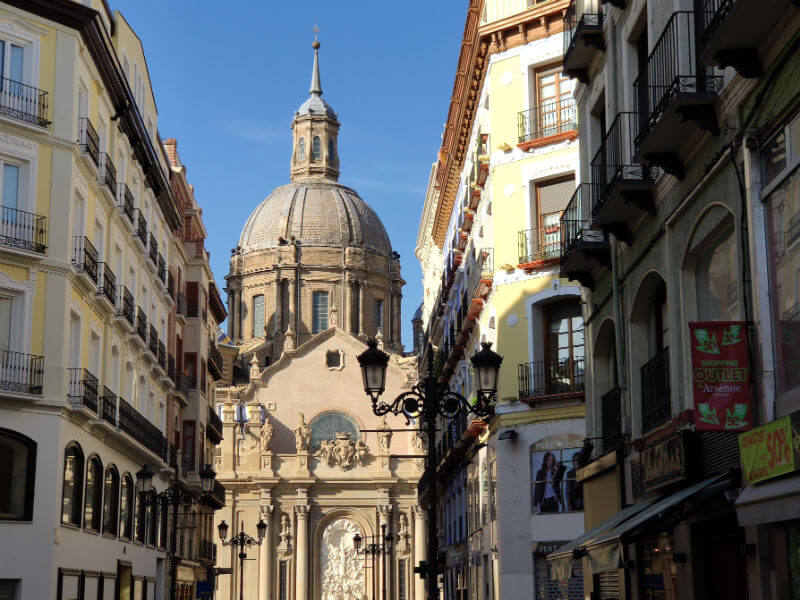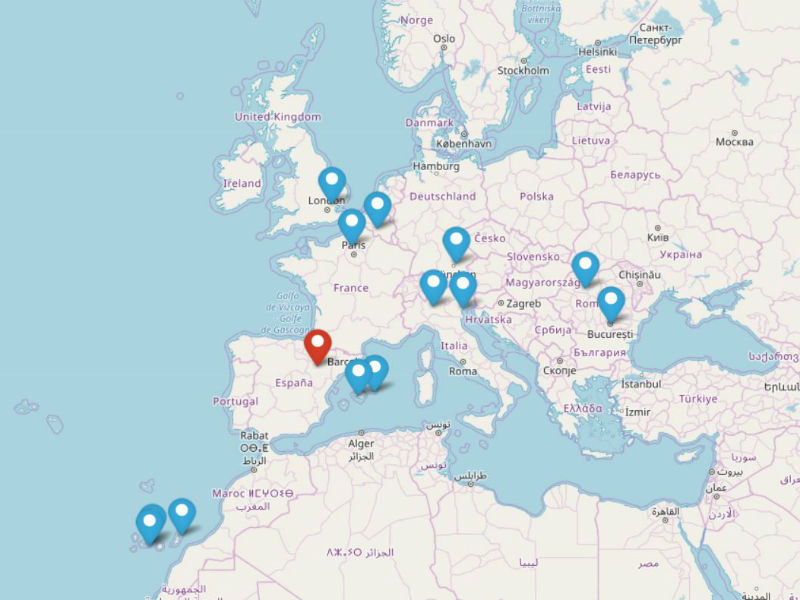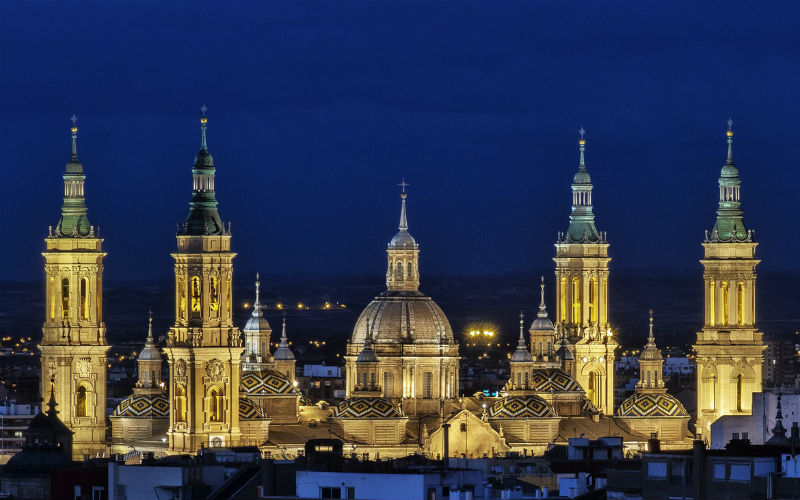It’s Spain’s fifth-largest city, capital of the Aragón region, and a place that one of the most influential artists in the country called home, but is Zaragoza worth visiting?
In a word, yes, I would happily recommend visiting Zaragoza to anyone who happens to ask me. It makes an excellent visit for a few hours if you are breaking up a train journey, or an attractive option for those looking for a weekend city break in a place that is away from the traditional tourist cities.
Coming your way in this post - click to expand ->
Affiliate disclosure: The links to tours or accommodation in this post are affiliate links. This means if you purchase after following one of these links, I make a small commission at no cost to yourself. Think of it like a win-win.
All about Zaragoza
Zaragoza has a rich history of prosperity and invasion and as such, many stories to tell. From the founding of the stunning Basílica de Nuestra Señora del Pilar, when St James had a vision of the Vigen Mary over the Ebro, to the second siege of Zaragoza when the city fell to Napoleon’s invading army, there is much to discover.
But it’s not just history. Food and drink also take center stage in this city and El Tubo is certainly up there with some of one of the best tapas experiences in Spain.
Given its position between Spain’s two biggest cities, it makes a great choice as a day trip from Barcelona or Madrid using the high-speed train.
So now I have whetted your appetite, let’s learn a little more about the Aragónian capital.
A bit of History
Roman
It was around 24BC that the legions who had been a part of the Cantabrian Wars fist founded the city that is known today as Zaragoza. Back then, it quickly became an important city named Caesaraugusta, after the Emperor.
The city became home to over 30000 inhabitants and boasted state of the art sewers, a large forum and a theatre that could hold over 5000 people. The easy access between the Roman forum and the banks of the River Ebro meant the city prospered as an important trading center of the region.
It was in the fifth century that the decline of the Roman Empire led to the city being peacefully taken by the Goths.

Moorish Period
In the 11th century the city, as did much of Spain, fell to the power of the Moorish invasion from the south and became the Taifa of Zaragoza, an independent Muslim state. Although the Moorish occupation only lasted around 100 years before the Aragonese took the city, many of their influences are still visible today, the most prominent of these is the Aljafería Palace.
Christian Period
Throughout the next 800 or so years the city continued to thrive, mainly thanks to its position on the banks of the Ebro, Spain’s second-largest river (largest that is entirely in Spain). It was during this period that both the Basilica del Pilar and La SEO Cathedral were evolved into the magnificent buildings they are today (their roots go further back), and talents such as Goya were nurtured.
The next period of uncertainty came at the hands of the French in the 19th century, but Zaragoza did not give up easily. In 1808, twice the city came under siege. The first one in August of 1808, Zaragoza bravely defied the French army who due to defeats elsewhere had to retreat. However, they came back in the winter for the second siege of Zaragoza. While the city proved defiant, after a month of brutal street combat and house to house fighting, the city finally fell on the 20th of February 1809.
The brave defense of the city is immortalized in the naming of streets and plazas throughout Zaragoza, two of the most prominent examples are Independence Avenue (Paseo de la Independencia) and Square of the Sieges (Plaza de Los Sitios).

The Spanish Civil War Years
While the city of Zaragoza itself didn’t play too much of a role in the war, the town of Belchite lies about 60 km south and is the site of one of the most infamous battles in the Spanish Civil war, and was part of the Zaragoza offensive.
Nowadays
Zaragoza is still a vibrant city that seamlessly blends culture with modern infrastructure. The historic core is centered around the Plaza del Pilar, where you will find the impressive Basilica del Pilar, City Hall, Tourist offices and the impressive Fuente de la Hispanidad.
Adjacent to this square is the Plaza de la SEO, where you can find the La SEO Cathedral and the historic Roman core in the Cesaraugusta museum. It would be easy to spend a day in Zaragoza and not get past these two plazas, but you should miss out on Stone Bridge that spans the Ebro or Paseo de la Independencia.
What to see in Zaragoza: Top 5 things to do
Here is a brief introduction to the top things to do in Zaragoza. If you would like to see a more comprehensive list, be sure to check out my other post about Zaragoza, 12 must-see sites.

1. Basilica del Pilar
This is probably the most iconic site in the city. The domed basilica with four large towers on each corner stands with one side facing into the plaza, the other onto the banks of the River Ebro. The basilica is named after the Virgen del Pilar, which resides inside, a dedication to where Saint James, a disciple of Jesus, had a vision of the Virgen Mary over the Ebro.
The basilica is free to enter, and highlights include the Virgin del Pilar, the massive organ, a stunning carved altarpiece and a dome in the ceiling that has been painted by Goya. It is also possible to pay €3 to access to the top of one of the four towers for some spectacular views over the city and the Ebro.
2. Tapas in El Tubo
Ohh El Tubo, how you imprinted yourself in my heart. This was probably my favorite part of the city, a network of small alleyways packed with bars selling all different types of tapas. What I adored was the fact that each place specializes. There was a bar that sold just croquettes and beer, another specializing in mushrooms. There was also one for migas, potatoes and more. The one thing they all had in common, good beer and good wine.
We spent an evening hopping from bar to bar, trying the different dishes and couldn’t find a bad one. If you are asking is Zaragoza worth visiting, I would happily say yes for the evenings spent tapping in El Tubo alone.

3. La SEO Cathedral
Located on an adjacent plaza, La SEO Cathedral stands on the site that was once a mosque during the Moorish occupation of the city and has been added to over the years to become what it is today, an eclectic mix of architectural styles.
Once inside, there are many small chapels, each telling its own story and once again, a stunning altarpiece.
Entrance to La SEO Cathedral is €4 which also includes access to the tapestry museum upstairs, one of the finest collections of large tapestries in the world.
4. Goya Museum
Alongside Dali and Picasso, Goya is probably one of Spain’s most famous artist, and he grew up in this city. Unsurprisingly, this means there is a museum to show off his works. The Goya Museums. The museum has 14 original Goya works alongside over 1000 other pieces of art from the same period.
Entrance to the museum cost €6 for adults, €3 for under 18s or over 65s.

5. Fiestas del Pilar
Everyone loves a party, right? Well, if you time your visit to coincide with Zaragoza’s main festival, you will be in for one. The annual Fiestas del Pilar last for nine days and are a celebration in honor of the Virgen del Pilar. That’s whole nine days of parties! The main day of the festival and the one not to miss is the 12th of October when thousands of people dress in traditional costume and lay flowers at the Virgen. This builds up into a spectacular pyramid display.
If you are considering visiting Zaragoza and wondering about the best time to visit, if you love a fiesta atmosphere, on or around the 12th of October would be perfect. On the other hand, if crowds aren’t your thing, avoid these dates!
Only have a few hours in Zaragoza?
As I mentioned in my introduction, if you have the opportunity to spend a few hours in Zaragoza, usually due to a train change, I think it is certainly worth the effort. The city center is a quick taxi ride from the train station and you can easily enjoy some of the main sites with not a lot of time.
Here is my suggestion of what to do in Zaragoza in a few hours:
- Visit the Basilica del Pilar and head to the top of the tower for the amazing views
- Grab something to eat in El Tubo
- Head to Stone Bridge to cross the Ebro and get some wonderful pictures of the Basilica
- If you have time to visit La SEO Cathedral, go for it, otherwise, enjoy the atmosphere in Plaza del Basilica and check out the Fuente de la Hispanidad
Another option could be arranging a tour with a local tour guide, this will ensure that you make the most out of your time in the city.

When is the best time to visit Zaragoza?
Aside from the week mentioned above, the city is perfect for a visit at any time of the year. With an average temperature in winter hovering around 7°c (45°f) and the peak for summer in July and August around 26°c (78°f), Zaragoza is comfortable to visit at most times of the year. Bear in mind these are average temperatures, most summer days do reach 30°c (86°f), and winter can often get below 0°c (-32°f).
Getting to Zaragoza
Zaragoza Airport
Zaragoza Airport is a small international airport, located around 10 kilometers from the city center, with flights to 14 different major destinations.
From the UK, flights are available most days of the week out of London Stansted and are operated by Ryanair. If you can book about a month or so in advance, you can expect to pay between £40 – £50 each way for the 2-hour flight, plus baggage fees of course. As usual, with Ryanair, it gets closer to £200 each way if there is low availability.

How to get to from Zaragoza airport to the city center
Buses run to the city center from just outside the terminal building every 30 minutes throughout the day. Look for the number 501 which costs €1.85 each way and takes around 25 minutes to get to the center. Click here for further information and full timetable.
Another option would be a taxi which (as usual) is much quicker but more expensive. You can expect to pay around €25 for a taxi.
Zaragoza train station
Due to its position as a stop along the high-speed train line that connects Spains two largest cities, Madrid and Barcelona, many people arrive at the city via train into the Delicias Train Station. The station was built in 2003 and is located around 3 kilometers from the city center.
How to get to from Zaragoza train station to the city center
There is the option of either a local bus or taxi to get to the city enter. The bus is a bit of a pain, but cheap, they are urban busses so make plenty of stops along the way but cost just a little over €1. Expect it to take about 25 minutes.
Taxis are plenty and take just 10 minutes and cost around €10.
Arriving by bus
Your bus will most likely arrive at Zaragoza Central Bus Station, which is alongside the Delicias Train Station so you can expect the same options as mentioned above when arriving by train.
Zaragoza by car
The Spanish intercity motorways are a delight to drive, however, driving in city centers can be a little more temperamental. The roads connecting the main cities are well maintained and light on traffic, as long as you avoid the main holiday traffic.
On my recent visit I was driving, and while the outskirts of the city were easy, there were a couple of times that I felt my sat nav took me into areas I shouldn’t be. The roads merged with the pavement, and it felt like I was driving in a pedestrian area, especially when trying to locate our hotel in Plaza del Pilar. However, I still haven’t received a ticket, so I guess it was all OK.
Parking in Zaragoza
If you are staying in the center, the chances are you will have to put your car in a car park as there is minimal street parking available. Expect to pay around €15 for an overnight stay but be sure to talk to your hotel reception as many of them offer discounts on parking rates.
Hotels in Zaragoza
If you are staying overnight, or longer, I would recommend finding a hotel close to the Plaza del Pilar. We stayed in the Hotel Tibur which I would happily recommend for the location, it was on the corner of the plaza, but not right in the heart of it, so we were not disturbed by noise, even though our room had a window facing the square. The room was OK, and breakfast adequate, but for €70 per night, I felt it offered good value.

Check out more hotels from booking.com below:
Booking.comSo, is Zaragoza worth visiting? Final thoughts
As a city that is steeped in history, there is plenty to keep you entertained for a few hours to break up a train trip or few days if you want to stay for longer.
What I really loved is that I found it a relaxing weekend break. While there was plenty to keep us busy, I didn’t feel overwhelmed. I didn’t feel I had to plan each day in fine detail to ensure we didn’t miss out on anything which can sometimes be the case in larger cities.
We took a pretty relaxed approach and after two-nights felt that we had seen as much as we had liked to and were ready to head home. Of course, if you wanted to explore a little further, Zaragoza makes the perfect base to explore some beautiful Aragón villages such as the previously mentioned Belchite, alternatively, you could head to Taragoza, a lovely steep-sided town, or Borja, home to the regions wine production and the Ecce Homo, a viral sensation.
While we’re talking about wine, you are also within touching distance of the iconic Rioja wine region, so a day trip to visit some famous vineyards could also be an option.
So while it may be a Spanish city that doesn’t carry the fame of some of the countries other offerings, if you have the opportunity to visit this historic city, it is well worth keeping on your radar.
